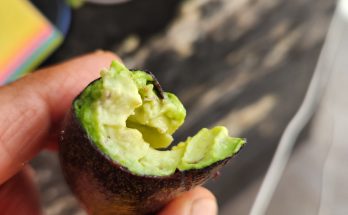By Valeria Ascencio Gómez
We are standing in front of a simple wooden door in San Miguel, unnoticed by most passersby. It is the home office of the architect Peter Van Lengen. His wife Verónica welcomes us with a warm smile and guides us through a corridor with two parallel rows of bamboo, like soldiers on the red carpet. His office is a living display of natural materials: wood and jute furniture, fired clay frets, and walls with different finishes, such as exposed brick, adobe, and yellow, red and ocher earth worked so the surface feels like the smoothest mother-of-pearl shell. These and other natural materials have been used in buildings such as Centro Imagina, a cultural space almost 3,500 m2 in León, Guanajuato, as well as homes damaged by the 2017 earthquakes in Hueyapan, Morelos.
Peter makes his way into the kitchen, where they offer us coffee. He is tall, walks with ease, and wears comfortable clothes, and flip flops… a subtle wink to his father’s work, The Barefoot Architect, a book considered the Bible of Bioarchitecture.
Who is Peter Van Lengen?
In his own words, “I was born in San Francisco, California, to a Dutch architect father and a Brazilian painter and journalist mother. I was raised in Mexico City. Of the whole family, I am the most Mexican. My other siblings did not feel it like I did, but I became like Chabela Vargas… just like that: the Mexican born in California.”
Johan Van Lengen and his book
The death of his father is so recent that Peter still has a hard time talking about him in past tense. “My father (1930-2021) is a… he was an architect trained in the United States. He wrote this book in 1980, and as time went by it became a university book as a result of the different environmental and health problems and ecological movements.
The story that a friend had an architect who ran him over and bought the book and finished his house with just the book is a classic. Of course, as an architect that does not suit me, because they are doing away with the architect … hahaha.
The book was translated into English, Portuguese, French, Turkish, and Chinese. The funny thing about this is that theme of the book has a lot to do with China´s culture and Mao Tse Tung: the importance of health… they see everything in the long term… their social movements are long term by tradition. This was not because of Communism. When doctors left the hospital after years of study, they had to go out into the fields for two years and teach the peasants to be “barefoot doctors”, that’s what they were called.
When my dad heard about this philosophy he said, ‘Oh geez… well, we need barefoot architects, also.’
He realized through all his social work, that with simple details people could improve their homes dramatically. His idea was to write a book that was easy to understand, with drawings. Easy for anyone to have a better ecological, very natural, and healthy home… We will always return to the health issue because we have about 100 years in which the more the way of life is modern, the more insane we are… We live longer, but sick.”
TIBA Ranch and the death of my mother
“My parents bought a small sugar mill in Brazil and turned it into an ecological ranch. They already had the book and they had the workshop, now they put into practice everything they were doing on a day-to-day basis. They named it TIBA (Intuitive Technology and Bio Architecture). Intuitive Technology is everything that, let’s say, is not studied; it comes from the subconscious, from what you do naturally… like making a fire.
In 2003 I returned with my family to live on the ranch and help my father. It was then that my mother died of cancer… My mother was a healthy woman, with a good diet and lived on a ranch.
It is something that hit the whole family very hard… but at the professional and personal level it´s when I embraced this idea of the Casa Sana. I became almost militant, very extreme in the sense that the materials used in the house had to be 100% natural and healthy. Now I do hybrids, but at that time I didn’t even want to use wi-fi.
With my father’s fame, I was able to invite the world’s greatest architects to the ranch. Half were his friends, and the other half wanted to meet him. We were able to raise the visibility of the book, and the ranch was consecrated as “the ecological ranch of Brazil.” We had several projects on the ranch, not just architecture: domes, plantations, reforestation, bamboo, biological filters, and everything that involved making a healthy construction. That was where I really did my master’s degree; every time I liked a teacher I invited and invited him until I was a mini teacher of his subject. I became, not an expert on a specific topic, but a connoisseur of all of them in general. With that broad vision, I could be very useful when doing projects: from the location, the soil, the impact of the construction… in short, I could give a very good diagnosis of all the areas of the project.”
Social Work
“I have been involved in various social projects. As of today, we are building more than 170 houses, cultural centers, and clinics, rbanizing indigenous villages in Marañón, Brazil. It has been complicated but super interesting. It is a beautiful job and a challenging one: it is the jungle and your transport is a canoe. Draw water from the forest, look for the appropriate land.
We also joined the architects who went to southern Mexico to help the towns affected by the 2017 earthquake. Specifically, to Hueyapan, Morelos, a very beautiful town, very traditional, all adobe. When I got to the town I said ‘This is my thing, I could stay here forever,’ because in the cities, the bluff, the concrete… What was I going to do? There are thousands of better-qualified architects, but in an adobe town it made perfect sense to be there. It was mi mero mole (my thing) and I could contribute, I could help people. I tried to be like the adobe expert. I would go to the houses and give suggestions, see the construction´s conditions.
After a year of working in Hueyapan we won the “Levantemos México” scholarship, and with the scholarship money we made a house for a lady who attended all my courses. Her name is Laura, and she was my #1 fan. We told her, ‘in one month we’ll return to build you a house.’ She surely did not believe us, but we came back and did it. I remember a villager in Africa who told me, ‘Güeritos like you come every month, they make us promises and then they don’t come back.’ He was right, the money was never authorized and we couldn’t go back.
So, I only promise what I can make.




